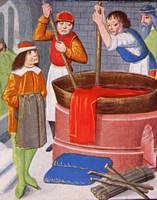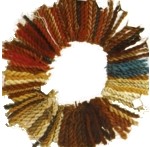|

fabrics
& sewing
sewing
tools
sewing
techniques
basic
medieval
clothing
sewing
tutorials
commercial
patterns &
what to do
about them
dyes
&
colours
fabric,
fur
& leather
names
embellishments
& embroidery
buttons
& lacings
|

Medieval
Dyestuffs, Dyeing & Colour Names
DYESTUFFS - MORDANTS & FIXATIVE - NOTES ABOUT
COLOURS - MEDIEVAL COLOUR NAMES
 The
rural medieval woman was often responsible for dyeing her own
fabric using natural substances which were collected locally.
Her city counterpart often had the luxury of purchasing fabric
which was already dyed with superior substances and better mordants
providing richer colours which lasted longer. The
rural medieval woman was often responsible for dyeing her own
fabric using natural substances which were collected locally.
Her city counterpart often had the luxury of purchasing fabric
which was already dyed with superior substances and better mordants
providing richer colours which lasted longer.
Dyeing and dyestuffs is a
huge topic, so what you'll see here is a very brief overview of
dyeing and dyestuffs in medieval England and Europe. For a more
comprehensive look at dyes, dyestuffs and natural dyeing, visit
the links page.
The detail at right comes from 1482, the Liber de Natura Rerum,
a Flemish manuscript which shows dyers stirring a vat of cloth.

Dyestuffs
Natural dyes came from various sources, the most common ones are
listed below:
red - madder root,
Rubia tinetorum, kermes or grana from insects
blue - woad leaves, Isatia tinctoria
violet - orchil from lichen
crimson - brasilwood from the East India tree
purple - brasilwood from the East India tree
yellow - weld, dyers' rocket, turmeric, saffron, onion
skin, marigold, chamomile
green - indigo, weld, turmeric
brown - walnut shells, bark
Red dye which came from madder
was significantly more expensive than the blue dye which came
from woad. The root of the madder plant required for the red dye
was only harvested once a year, whereas the leaves of the woad
plant could be gathered several times throughout the year, making
it a more available product.
Flanders was a particularly
successful area for fabric production and dying. The rich soil
was good to grow plants used for dyeing and the area had an abundance
of Fuller's Earth which was used for cleansing of wool.

One historic
dye book which gives recipes and instructions on making dye is
the German Innsbruck Manuscript from 1330. A selection
of dye recipes are included below.
Brown
- Take filings and rusty iron and soft pitch, and let it boil
long together; that makes a good brown on a red fabric.
Black
- Take green nutshells and grind them together and let them
rot seven days in a pot, and therewith make a black dye.
- Whoever wants to make black dye, he takes oak galls and pulverizes
them and adds alum thereto and boils it in a skillful way with
alum and in urine and dyes therewith; if he wants to make it
darker, add black dye thereto.
Red
- Take chalk in a pot and pour water thereon and mix it well
together and let it sink to the bottom of the pot so that the
water becomes clear and and take that same water and boil the
brazilwood well therin, until it is cooked and then mix in alum
and with it dye red zendel (a thin silken material).
- Whoever wants to dye whatsoever he wills red, takes cinnabar
and rubs it well on a hard stone with alum-water and uses that
to dye with. If he wants to make a red color darker, he mixes
it with black dye or with verdigris and adds alum thereto; then
he cooks everything in lime water and takes brasilwood and boils
everything in human urine.
- Also, brasilwood mixed with alum, mixed with lime water or
with urine.
- One should take lead oxide and should boil it with lime water/vinegar,
upon which the colour becomes the colour of tiles, and should
mix it with alum, and a flower in the field named zindlot should
also be boiled in alum-water and strain it through a cloth,
and dye therewith.
- One should take crabs and boil them well in water and throw
out of the pot everything within the shells and boil the rest.
Grind well in a mortar, and strain through a cloth and mix it
well with alum, upon which the color becomes reddish; or if
one wishes to make the color darker, add verdigris thereto.
- Take brasil wood and maple as much as you wish and boil it
well in lime water and take then alum and gum arabic thereto,
so the brasilwood and the maple are well cooked, then let the
alum and gum arabic seeth together, and therewith color red
upon white.
Yellow
- Whosoever wishes to make yellow dye, takes orpiment and mixes
it with alum, cooked in lime water, and dyes therewith.
- One should take barberries and peel the outer rind off; then
one should peel off the green and boil it with alumwater and
add brasilwood thereto and orpiment and dye therewith.
Green
- To make a green dye, take verdigris and boil it in urine and
mix alum thereto and a portion of gum arabic, and dye therewith;
to make the color lighter, take the same color and add orpiment
and mix it with alum, cooked in lime water and dye therewith.
- One should take elder and boil it in alumwater, that makes
a green color and also a black, if one mixes it with a bit of
black color.
Blue
- Whoever wishes to make a fast blue, take ground lapis lazuli
pigment in lime water and boil it with gum arabic and with alum
and dye therewith. If he wishes to make it dark, add black dye
thereto and blue flowers which stand in the field, and mash
it well and boil it in urine and mix it with alum and dye therewith.
- Take the leaves of a dwarf elder and mash them and take indigo
and add thereto and grind it together and let them dry together
for a long time and take lime water and let it seethe together
and then take alum and grind it thereto while it's all hot.
Paint it on white fabric, and it will become a good blue.

Mordants
and fixatives
By 1200, Europe imported alum from Sicily and North Africa which
was used as a mordant for fixing the colours in woolen cloth.
The purpose of the mordant is to assist the dye in sticking to
the material. It also improves the permanence, colorfastness and
light fastness of the dye itself. Some mordants change the tone
of the colour of the dye. Iron was used to darken colors or to
tone down brightness and was often used as a post-dye bath.
Ammonia, readily available
to all walk of life in the form of stale urine, was a key ingredient
in processing woad. It was also used to adjust the acidity levels
which alters colors in various dyes, like madder.
The mordant most in use over
the medieval period was alum, which could be used both in the
dye bath or as a pre-mordant. Alum brightens colors without really
changing the color itself. Too much alum can make woolen fibres
sticky and tartaric acid was often used with to counteract this.
Finds from Coppergate show the use of club moss which was used
an alternative to mined alum. The moss is high in natural alum
and was useful in areas where alum was difficult to obtain.
Copper is another metal-based
mordant which was widely used. It tends to add a blue-greenish
cast to dyes. In many cases, dyeing in a copper pot might be all
that was required to mordant the fibres.

Notes
about colours
It must be noted that just because it was possible for a colour
to be dyed, it did not mean that it was instantly adopted by all
walks of life. Many colours were deemed unsuitable for the peasant
class. Bright colours, it was thought, were not humble and engendered
a feeling of pride which was a mortal sin. Peasants should remember
where it was that God had seen fit to place them, and they should
not desire anything other than God's will.
Clothing in greys, browns and muted blues were thought most suitable
for the lower class. This did not mean that peasants were dowdy.
Greys and browns were available in a number of shades and clever
colour coordination of hoods and tunics could still make for an
attractive ensemble. Blue was a colour which was available to
most classes, both cheaply and expensively, in all shades ranging
from muted, sombre blues to brilliant jewel blues of the upper
classes.
Scarlet was a fabric
which was also known as a colour- causing great confusion
in clothing inventories, scarlet the cloth and scarlet the colour
often being misinterpreted. Scarlet, the fabric, was an expensive
fabric and limited to the very highest echelons of society. The
dye process used a certain amount of kermes for all of the colours
it was produced in- red, grey, black, dark grey and dark blue-
not just for the bright red colour scarlet.

Medieval
Colour Names
Many and varied are the names of colours used in medieval times.
When reading through manuscripts or old books, colours referred
to may be hard to distinguish. Listed below are those that I've
personally come across and their modern colour descriptions. Many
of these are obsolete today.
A
abraham brown
abram brown
aurnola orange
B
bowdy scarlet
biffe "blotted out" stripes
brassel red
brasil bright red
bristol red
brun brown
brunetta lighter brown
burel dark red woollen
burnet brown
C
carnation raw flesh colour
carsey yellow
cendre dark grey
cendryn grey
celestrine light blue
checkery checked cloth
ciclaton originally scarlet, then cloth of gold
cramoisy crimson, bright red
crocus yellow
cyclas purple
D
E
echiqueles checked fabric
F
falwe yellow
G
garance madder
gingerline reddish-violet
goose-turd yellowish green
graine cochineal red
gris grey
grisart light grey
gris brun drab
gris cindre ash grey
gris pommelle dapple grey
gros de dos d'asne donkey grey
|
H
hair bright tan
herbal brown-green
I
incarnate red
inde indigo blue, azure blue
isabelle yellow or light buff
J
jaune bright yellow
K
L
lincoln green
lustie-gallant light red
M
maidenhair bright tan
marble parti-coloured
medley a mixture of colours
mezereon rose-purple
milk-and-water bluish white
murrey deep claret or purplish-red made from mulberry
juice
N
O
orange tawny orange brown
P
paonace peacock
pavonalilis peacock
pear russett red
pers deep blue
perse bluish grey
plombes leaden grey
plonquies leaden grey
plunket medium blue or grey-blue
plunket celestyne sky blue
popinjay green or blue
puce purple of reddish tone
puke purple of reddish tone. Also described as dirty
brown
purpure purple |
Q
R
rats colour dull grey
roy bright tawny
russett a dark brown
S
sad dark tint of any colour
sanguin blood red
sangwyn blood red
scarlet bright red
sheeps colour neutral
stammel red
T
tanne tan, tawny
tawny dusky orange brown
tenne tawny orange brown
toley bright red
turkils turquoise
U
V
verdulet bright bluish green
vermel bright red
vermeil vermillion, bright red
vermillion bright red
vert green
violet purple
W
watchet pale greenish blue
woad blue
X
Y
ynde indigo blue
yellow-carsey yellow
Z
|

Copyright
© Rosalie Gilbert
All text & photographs within this site are the property of
Rosalie Gilbert unless stated.
Art & artifact images remain the property of the owner.
Images and text may not be copied and used without permission.
|